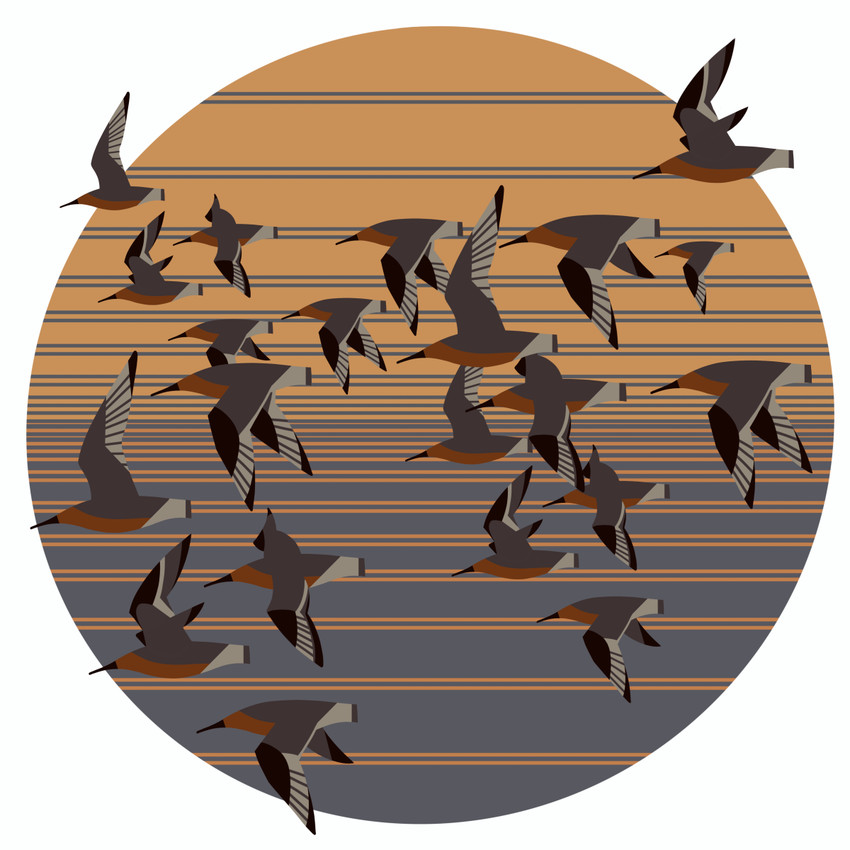5% of profits support Endangered & Threatened Species.
Each year, they can travel more than 9,000 miles from Tierra Del Fuego in South America to the Canadian Arctic- and BACK that same year in the fall.

COLOR PALETTE SAMPLED FROM IMAGES OF THE RUFA RED KNOT:

The Rufa Red Knot's migration stats are jaw-dropping. Each year, they can travel more than 9,000 miles from Tierra Del Fuego in South America to the Canadian Arctic- and BACK that same year in the fall. There is even one famed (& tagged) bird nicknamed Moonbird. Researchers estimated that throughout its (at least)19 years, Moonbird traveled farther than the distance from Earth to the Moon.
The following comes directly from the USFish & Wildlife site:
"Large flocks of rufa red knots arrive at stopover areas along the Delaware Bay and the U.S. Atlantic coast each spring, with many of the birds flying directly from northern Brazil. Spring migration is timed to coincide with the spawning season for the horseshoe crab, whose eggs provide a rich, easily digestible food source. Because it provides abundant horseshoe crab eggs, Delaware Bay is the single most important spring stopover habitat, supporting an estimated 50 to 80 percent of all migrating rufa red knots each year.
"Rufa red knot numbers in Tierra del Fuego (winter) and Delaware Bay (spring) declined about 75 percent from the 1980s to the 2000s. The smaller populations that remain now face many hurdles to recovery, including sea level rise; coastal development; shoreline stabilization; dredging; reduced food availability at stopover areas; disturbance by vehicles, people, dogs, aircraft, and boats; and climate change.
Road to recovery
The horseshoe crab harvest is now managed specifically for the protection of the rufa red knot. Knot populations appear to have stabilized in recent years, though at low levels. Listing of the rufa red knot in 2015 brought new protections. Some threats, like climate change, cannot be directly addressed under the ESA. But by limiting other threats – like horseshoe crab overharvest and human disturbance – the Service and our partners are giving the rufa red knot its best shot to adapt and cope with a changing world.

TO SHOP PRODUCTS FEATURING THIS DESIGN CLICK:HERE
5% of the profits from these products go to Threatened & Endangered Species.
BIODIVERSITY OF TEXAS SERIES:
With approximately 90 state and federal endangered species and 140 threatened species in Texas, Whitsett’s work underscores the urgency of conservation while emphasizing that protection is still possible.
Through the process of developing species-derived color palettes sampled from crowd-sourced images, Whitsett creates original artworks that draw inspiration from these distinctive palettes, as well as the lives and forms of the rarest and most at-risk. Collaborating closely with scientists and leading experts, she continually seeks to deepen her understanding of these species, contributing to both environmental education and conservation.
Juliet Whitsett is an Austin-based artist and environmental advocate specializing in biodiversity, ecological storytelling, and public engagement. Through research-driven art, she makes scientific knowledge accessible, inspiring awareness and action for the natural world.
HOW YOU CAN HELP:
So often I wonder what I can do to help our world- one easy thing I have found is to write my US house Rep. and ask them to support The Recovering America's Wildlife Act RAWA Find out more at https://www.txwildlifealliance.org/or if you aren't in Texas, https://ournatureusa.com/
SOURCES:

